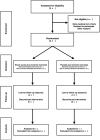Shock wave therapy associated with eccentric strengthening versus isolated eccentric strengthening for Achilles insertional tendinopathy treatment: a double-blinded randomised clinical trial protocol
- PMID: 28132005
- PMCID: PMC5278235
- DOI: 10.1136/bmjopen-2016-013332
Shock wave therapy associated with eccentric strengthening versus isolated eccentric strengthening for Achilles insertional tendinopathy treatment: a double-blinded randomised clinical trial protocol
Abstract
Background: There is no consensus regarding the treatment of Achilles insertional tendinopathies. Eccentric training remains the main choice in the conservative treatment of this illness; however, the good results in the management of non-insertional Achilles tendinopathy were not replicated in the insertional condition. Low energy shock wave therapy has been described as an alternative to these patients, but has yet to be empirically tested.
Hypothesis: Shock wave therapy, adjunctive to the eccentric strengthening protocol, will improve measures of pain and function.
Design: Double blind, placebo-controlled, parallel groups, randomised clinical trial.
Materials and methods: 93 patients with a diagnosis of chronic insertional tendinopathy, referred from primary or secondary healthcare services, will be assessed and enrolled in this study. They will be divided into two groups (randomised by sequentially numbered identical envelopes, which will be administered serially to participants), one containing the combination of low energy shock wave and eccentric exercises, as treatment and the other comprehending the exercises and the placebo treatment (an apparatus placed in the therapeutic head). The assessments will occur in 2, 4, 6, 12 and 24 weeks. Patients will be evaluated primarily by the Victorian Institute of Sport Assessment-Achilles questionnaire and secondarily by the visual analogue scale, Algometry, the American Orthopedic Foot and Ankle Society scale, the Foot and Ankle Outcome Score and the 12-item Short Form Health Survey. We will use comparison of two proportions via relative frequency analysis, the Pearson Correlation the χ2 test and the analysis of variance for statistical analyses.
Discussion: This study intends to demonstrate if the association of the eccentric exercise programme with the shock wave therapy can produce good results regarding the treatment of the Achilles insertional tendinopathy. In an attempt to prevent the high costs and complications associated with the surgical intervention, we will try to prove this combination as a viable therapeutic option in the conservative management of this prevalent condition. The strengths of the study are the design and the novelty of the combination of methods. The main limitation is the short follow-up course.
Ethics and dissemination: The study is registered in the Clinical Trials database (protocol number: 8094833648737701) and was approved by the University Ethics Committee (number: 1373481).
Trial registration number: 8094833648737701 (NCT02757664); Pre-results.
Keywords: achilles; eccentric; insertional; shock wave; tendinopathy.
Published by the BMJ Publishing Group Limited. For permission to use (where not already granted under a licence) please go to http://www.bmj.com/company/products-services/rights-and-licensing/.
Conflict of interest statement
Conflicts of Interest: None declared.
Figures
References
Publication types
MeSH terms
Substances
Associated data
LinkOut - more resources
Full Text Sources
Other Literature Sources
Medical

